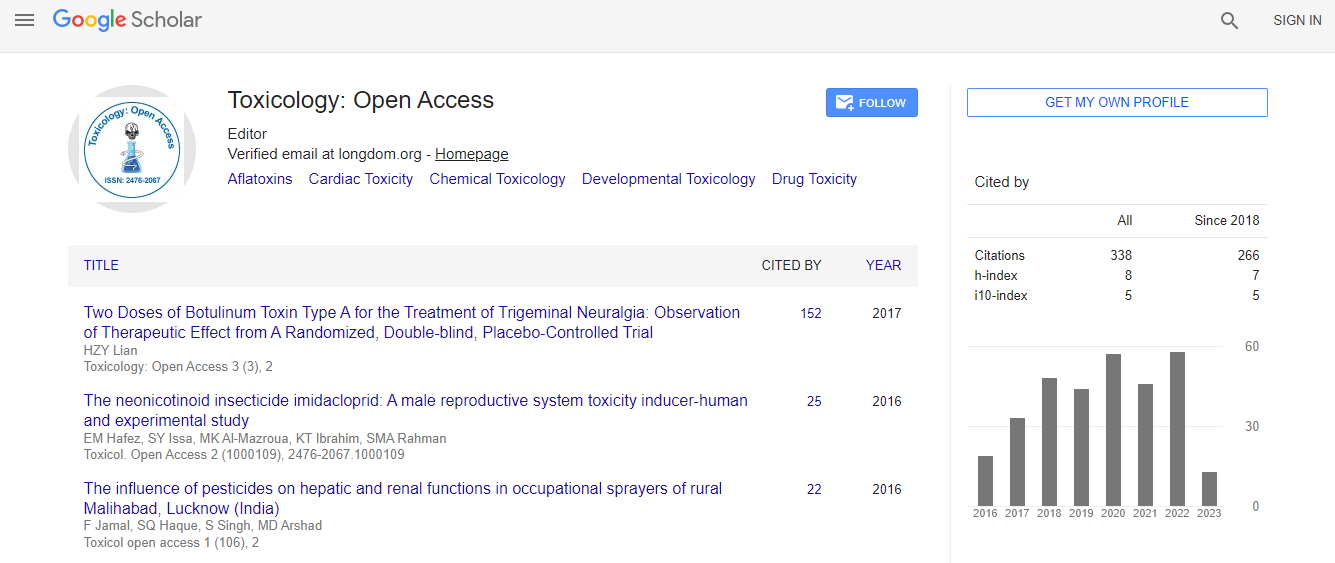Our Group organises 3000+ Global Conferenceseries Events every year across USA, Europe & Asia with support from 1000 more scientific Societies and Publishes 700+ Open Access Journals which contains over 50000 eminent personalities, reputed scientists as editorial board members.
Open Access Journals gaining more Readers and Citations
700 Journals and 15,000,000 Readers Each Journal is getting 25,000+ Readers
Google Scholar citation report
Citations : 336
Toxicology: Open Access received 336 citations as per Google Scholar report
Indexed In
- Google Scholar
- RefSeek
- Hamdard University
- EBSCO A-Z
- Geneva Foundation for Medical Education and Research
- Euro Pub
- ICMJE
Useful Links
Related Subjects
Share This Page
Ionizing radiation induces developmental abnormalities but not lethality of sea urchin embryos
14th World Congress on Toxicology and Pharmacology
Mahmoud Ibrahim Shoulkamy, Toshiaki Nakano, Amir Salem and Hiroshi Ide
Minia University, Egypt Hiroshima University, Japan National Research Centre, Egypt
ScientificTracks Abstracts: Toxicol Open Access
Abstract
The Fukushima nuclear power plant accident occurred in Japan on March 2011, initiated by tsunami following a great earthquake cause the discharged of radioactive materials into the environment. This accident received considerable attention for their effect on marine ecosystems. Sea urchins are model organisms in developmental biology research and their embryos are sensitive to toxins and used to study the developmental and cytological effects of anthropogenic pollutants and environmental stressors. In the present study sea urchin embryos were used as a model system to assess the effect of ionizing radiation on the viability and early development of marine invertebrate animals. Sea urchin embryos were culture in filtered sea water at 16 �°C at the different developmental stages were irradiated with X-rays (70 kV, 0.2 mm Al filter, dose rate=1.46 Gy/min) and further incubated in filtered sea water at 16 �°C. Irradiation of embryos at the different stages of development (32cell, mid-gastrula and early Pluteus larva) at doses up to 30 Gy did not reduce the viability of embryos. However, irradiated embryos exhibited dose-dependent developmental abnormalities. Typical abnormalities observed for gastrula embryos were delayed development and a reduced number of primary and secondary mesenchyme cells and those for mid Pluteus larva were delayed development, skeletal abnormalities, separated body rod tips and fused arms. Interestingly, the frequency of X-rays induced abnormalities increases when embryos were irradiated before mid-blastula transition (MBT) and starts to decrease thereafter. The analysis of apoptosis of X-ray irradiated embryos resulted in the absence of apoptotic response when embryos were irradiated before MBT. However, there is immediate apoptotic response was observed when embryos were irradiated after MBT. Recent Publications 1. Shoulkamy M I, Nakano T, Ohshima M, Hirayama R, Uzawa A, Furusawa Y, Ide H (2012) Detection of DNA-protein crosslinks (DPCs) by novel direct fluorescence labeling methods: distinct stabilities of aldehyde and radiation-induced DPCs. Nucleic Acids Research; 40(18): e143. 2. Ide H, Shoulkamy M I, Nakano T, Miyamoto-Matsubara M, Salem A M (2011) Repair and biochemical effects of DNAprotein crosslinks. Journal of Mutation Research; 711(1-2): 113-122.Biography
Mahmoud Ibrahim Shoulkamy has his expertise in DNA damage response to environmental and anticancer agents and risk sciences of radiation and chemicals. He has received his Doctoral degree from Graduate School of Science, Hiroshima University, Japan in 2013 in the field of DNA damage and its repair mechanisms. In 2013, he was appointed as an Assistant Professor (special appointment) in Graduate School of Science, Hiroshima University, Japan until 2016 and currently he is working as an Assistant Professor in Zoology Department, Faculty of Science, Minia University, Egypt.
Email:mahmoud.ibrahim@mu.edu.eg

 Spanish
Spanish  Chinese
Chinese  Russian
Russian  German
German  French
French  Japanese
Japanese  Portuguese
Portuguese  Hindi
Hindi 